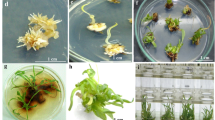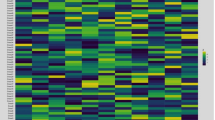Abstract
The usefulness of breeding to improve sugarcane (Saccharum sp. hybrids) crop performance and productivity depends heavily on the continued availability of new and beneficial genes and on novel approaches to the reproductive and agronomic controls used to access their full potential. One such novel approach is perhaps in the study of full or partial (variegation) albinism, an underexplored topic with implications both in sugarcane cultivar development and crop production. In sugarcane and other domesticated cereal grasses, cell culture (e.g., anther, callus, and immature embryo culture) has been employed via haploid and diploid embryogenesis in order to obtain genetically favorable parents, though rates of albinism in the regenerated plantlets are significantly high and remain a major bottleneck. The rate of photosynthesis in sugarcane leaves is known to throttle down throughout the growing season, and there is evidence that sink availability provides strong feedback. How an albino tiller—a genuine photosynthate sink—will accumulate sugar and biomass and respond to light cues and senescence, as well as how the rest of the plant will respond to an albino tiller, is currently unknown. In this short communication, we discussed the significance, critical gaps, and potential future developments of albinism in sugarcane research.


Similar content being viewed by others
References
Abadie, C., M. Lamothe, C. Mauve, F. Gilard, and G. Tcherkez. 2015. Leaf green-white variegation is advantageous under N deprivation in Pelargonium x hortorum. Functional Plant Biology 42: 543–551.
Bastia, C., and G. Panigrahl. 1956. Spontaneous variegated chimera in Dianthus chinensis L. Current Science 9: 300–301.
Begum, M., M. Islam, M. Miah, M. Hossain, and N. Islam. 2011. Production of somaclone in vitro for drought stress tolerant plantlet selection in sugarcane (Saccharum officinarum L.). The Agriculturists 9: 18–28.
Chintapalli, P. 1995. Application of somaclonal variation in crop improvement of Pigeonpea. MS Thesis. http://oar.icrisat.org/711/1/61841.pdf.
Fernandes, A., and G. Benda. 1985. Distribution patterns of brix and fibre in the primary stalk of sugarcane. Sugar Cane 5: 8–13.
Fisher, D., and W. Eschrich. 1985. Import and unloading of C14 assimilate into nonphotosynthetic portions of variegated Coleus blumei leaves. Canadian Journal of Botany 63: 1708–1712.
Gill, N., R. Gill, and S. Grosal. 2004. Factors enhancing somatic embryogenesis and plant regeneration in sugarcane (Saccharum officinarum L.). Indian Journal of Biotechnology 3: 119–123.
Hartt, C., H. Kortshak, A. Forbes, and G. Burr. 1963. Translocation of C14 in Sugarcane. Plant Physiology 38: 305–318.
Inman-Bamber, N. 1994. Temperature and seasonal effects on canopy development and light interception of sugarcane. Field Crops Research 36: 41–51.
Inman-Bamber, N., G. Bonnett, M. Spillman, M. Hewitt, and J. Xu. 2009. Source-sink differences in genotypes and water regimes influencing sucrose accumulation in sugarcane stalks. Crop and Pasture Science 60: 316–327.
Irvine, J. 1984. The frequency of marker changes in sugarcane plants regenerated from callus culture. Plant Cell, Tissue and Organ Culture 3: 201–209.
Joshi, K., and D. Panditrao. 1942. Albinism in sugarcane. Current Science 11 (10): 402–403.
Khan, I., M. Dahot, N. Seema, S. Yasmeen, S. Bibi, G. Raza, et al. 2009. Direct regeneration of sugarcane plantlets: A tool to unravel genetic heterogeneity. Pakistan Journal of Botany 41: 797–814.
Khan, I., A. Khatri, M. Ahmad, S. Siddiqui, G. Nizamani, M. Khanzada, 1998. In vitro mutagenesis in sugarcane. Pakistan Journal of Botany 30: 253–261.
Kibite, S. 2002. Discovery of variegated leaf mutants in oats (Aventa sativa L.). http://wheat.pw.usda.gov/ggpages/oatnewsletter/v48/Mutants.htm. Accessed 19 April 2018.
Krishnamurthi, M., and H. Koike. 1982. Sugarcane collecting expedition: Papua New Guinea, 1977. Hawaiian Planters’ Record 59: 273–313.
Kumari, M., H. Clarke, I. Small, and K. Siddique. 2009. Albinism in plants: A major bottleneck in wide hybridization, androgenesis and doubled haploid culture. Critical Reviews in Plant Sciences 28: 393–409.
Lauer, J., and S. Simmons. 1988. Photoassimilate partitioning by tillers and individual tiller leaves in field-grown spring barley. Crop Science 28: 279–282.
McCormick, A., M. Cramer, and A. Watt. 2006. Sink strength regulates photosynthesis in sugarcane. New Phytologist 171: 759–770.
McCormick, A., M. Cramer, and D. Watt. 2007. Changes in photosynthetic rates and gene expression of leaves during source-sink perturbation in sugarcane. Annals of Botany 101: 89–102.
McCormick, A., D. Watt, and M. Cramer. 2008. Supply and demand: Sink regulation of sugar accumulation in sugarcane. Journal of Experimental Botany 60: 357–364.
Mittal, P., R. Devi, and S. Gossal. 2016. Effect of genotypes and activated charcoal on high frequency in vitro plant regeneration in sugarcane. Indian Journal of Biotechnology 15: 261–265.
Moir, W. 1932. Cane varieties or mutations? Proceedings of International Society of Sugar Cane Technologists 4: 8.
Moore, P.H. 1995. Temporal and spatial regulation of sucrose accumulation in the sugarcane stem. Australian Joural of Plant Physiology 22: 661–679.
Robertson, D. 1975. Survey of the albino and white-endosperm mutants of maize. The Journal of Heredity 66: 67–74.
Sandhu, H., P. Rott, J. Comstock, and R. Gilbert. 2017. Sugarcane leaf scald disease. http://edis.ifas.ufl.edu/sc001. Accessed Jan 2018.
Singh, A., and O. Singh. 1964. Studies into the metabolism of albinoid and healthy leaves of sugarcane. In Proceedings of the 5th conference of sugar research and development workers, 337–339.
Smiley, R. 2010. Albinism. In Copendium of wheat diseases and pests, ed. W. Bockus, R. Bowde, R. Hunger, W. Morrill, T. Murray, & R. Smiley, 3rd edn, 139–140. St. Paul, MN: APS Press.
Taghian, A., and H. El-Aref. 1997. Somaclonal variation and differential gene expression of albino and green sugarcane plants. In Proceeding of the first scientific conference of agricultural sciences faculty of Agri. Assiut Univ., (pp. 274–286). Assiut, Egypt.
Texas Invasive Species Institute. 2014. Sugarcane white leaf disease. http://www.tsusinvasives.org/database/sugarcanephytoplasma.html. Accessed Jan 2019.
The Experiment Station of the South African Sugar Association. 1980. Sugarcane Diseases in South Africa. Mount Edgecombe: Sugarcane Diseases in South Africa.
Vasil, I. 1986. Regeneration in cereal and other grass species. In Cell culture and somatic cell genetics of plants (Vol. 3). Orlando, FL: Academic Press Inc.
Wang, W., S. Cui, and C. Zhang. 2001. Plant regeneration from embryogenic suspension cultures of dunereed. Plant Cell, Tissue and Organ Culture 67: 11–17.
Weidner, M., H. Steinbiss, and B. Kremer. 1976. Correlations between Photosynthetic Enzymes, CO2-Fixation and Plastid Structure in an Albino Mutant of Zea mays L. Planta 131: 263–270.
Zhou, H. 1996. Genetics of green plant regeneration from another culture in cereals. In Vitro Haploid Production in Higher Plants: Volume 2: Applications, ed. S. Jain, S. Sopory, and R. Veilleux, 169–183. Springer Science & Business Media.
Zhou, M. 2005. The relationship between tiller population development parameters and cane yield of sugarcane. Proceedings of the International Society of Sugar Cane Technologists 25: 443–451.
Zubko, M., and A. Day. 1998. Stable albinism induced without mutagenesis: a model for ribosome-free plastid inheritance. Plant Journal 15: 265–271.
Author information
Authors and Affiliations
Corresponding author
Rights and permissions
About this article
Cite this article
Migneault, A., Sandhu, H., McCord, P. et al. Albinism in Sugarcane: Significance, Research Gaps, and Potential Future Research Developments. Sugar Tech 21, 536–541 (2019). https://doi.org/10.1007/s12355-018-0668-1
Received:
Accepted:
Published:
Issue Date:
DOI: https://doi.org/10.1007/s12355-018-0668-1




